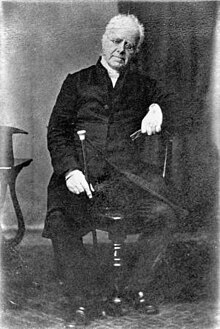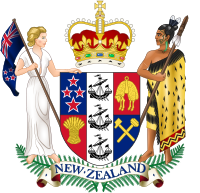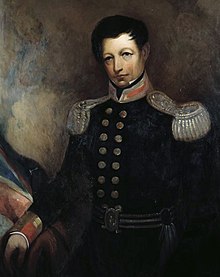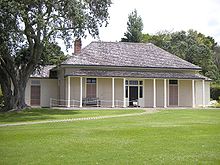Waitangi Treaty
| Treaty of Waitangi | |
|---|---|
| Closed on: | February 6, 1840 |
| First signatory: | William Hobson James Busby Henry Williams and about 45 Māori - Chiefs |
The Treaty of Waitangi , called in Māori : Te Tiriti o Waitangi ( Treaty of Waitangi ), is New Zealand's oldest constitutional charter . The contract was signed on February 6, 1840 at Waitangi in the Bay of Islands , on the North Island of New Zealand, by Lieutenant-Governor William Hobson , representing the British Crown, and 45 chiefs of the Northern Māori clans.
Contract documents
The Treaty of Waitangi in its still existing form does not consist of a single document, but of a total of nine documents, seven of which are written or printed on paper and two on parchment. On the day of the first signature, the main document of the contract was available in English and Maori. The other seven documents were handwritten copies that, after the original was first signed, were sent to other parts of the North Island and the north of the South Island for other clan chiefs to sign. Of these copies, only one document still exists in English, all others are in Māori . In 1841 the documents were saved from destruction in a fire that completely destroyed the government building in Auckland . However, improper storage of the documents between 1877 and 1908 led to the contract documents being severely damaged by moisture and infestation by rats. The documents that make up the entire contract today are structured and named as follows:
- Waitangi Sheet - (was badly damaged by rats)
- Manukau-Kāwhia Sheet
- Waikato-Manukau Sheet - (the only sheet in English)
- Printed Sheet - (contract in printed form)
- Tauranga Sheet
- Bay of Plenty (Fedarb) Sheet
- Herald (Bunbury) Sheet - (was badly damaged by rats)
- Cook Strait (Henry Williams) Sheet
- East Coast Sheet
The original was signed by William Hobson , James Busby , Henry Williams and about 45 clan chiefs, the first to be signed by Hone Heke , a member of the Ngāpuhi and one of their great leaders. A total of around 540 Māori leaders from 39 parts of the country signed the treaty, including some women.
Content of the contract
The treaty is divided into a preamble and three articles .
preamble
| English | translation |
|---|---|
|
HER MAJESTY VICTORIA The Queen of the United Kingdom of Great Britain and Ireland regards the native chiefs and tribes of New Zealand with her royal favor and endeavors to protect their just rights and property and to ensure them the enjoyment of the peace and good order necessary because of the large number necessary of Her Majesty's subjects already settled in New Zealand and the rapid expansion of emigration from Europe and Australia that is still under way to form and appoint an official duly authorized to deal with New Zealand's Aboriginal people for the recognition of Her Majesty's sovereign authority over all or part of these islands - Her Majesty therefore endeavors to establish a fixed form of civil government in order to avert the evil consequences which must arise from the lack of the necessary laws and institutions that both d resembling indigenous people as well as their subjects have been delighted to empower and authorize them orise me William Hobson, a captain to the consul of Her Majesty's Royal Navy and vice-governor of parts of New Zealand that may or may be ceded to Her Majesty To invite the Confederate and Independent Chiefs of New Zealand to agree to the following articles and terms. |
Here it is stated that the increasing immigration from Europe and Australia makes it necessary that orderly administrative structures are created. The rights and property of the Māori should be protected and security and order should be maintained. In return, the Māori recognize the sovereignty of the British Crown over all the islands of New Zealand. This section also gives William Hobson's authorization to sign the contract on behalf of the Crown.
article 1
| English | translation |
|---|---|
|
The Chiefs of the Confederation of the United Tribes of New Zealand and the separate and independent chiefs who have not become members of the Confederation surrender, absolutely and unconditionally, to Her Majesty the Queen of England all rights and powers of sovereignty which the Confederation or Individual Chiefs exercise or possess or possess or may exercise or possess over their respective territories as sole sovereigns thereof. |
Article 1 transfers all sovereignty to the British Crown.
Article 2
| English | translation |
|---|---|
|
Her Majesty the Queen of England affirms and warrants the chiefs and tribes of New Zealand and their respective families and individuals the complete, exclusive and undisturbed possession of their land, forests, fisheries and other properties which they may own collectively or individually for as long as they may it is their wish and desire to keep it in their possession; The Chiefs of the United Tribes and the individual chiefs, however, grant Her Majesty the exclusive right of first refusal for such properties, the owners of which can be sold at the prices agreed between the respective owners and persons appointed by Her Majesty, to deal with them on their behalf. |
Article 2 guarantees the Māori all individual and collective rights and ownership of the land, agricultural land, forests and fishing grounds they use, as long as they do not sell them to the state.
Article 3
| English | translation |
|---|---|
|
In view of this, Her Majesty the Queen of England grants the natives of New Zealand their royal protection, granting them all the rights and privileges of British subjects.
(signed) William Hobson, Lieutenant Governor. Now we, the chiefs of the Confederation of the United Tribes of New Zealand, gather in Congress in Victoria at Waitangi, and we, the separate and independent chiefs of New Zealand, the authority over the tribes and territories indicated by our respective names, To the provisions of the foregoing Understanding the Contract fully, accept it and enter into it in the full spirit and meaning on whose testimony we have placed our signatures or marks in the places and dates indicated. Done at Waitangi on the sixth of February in the year of our Lord one thousand eight hundred and forty. |
Article 3 grants the Māori the status of British subjects.

Legal effect
" The Treaty ", as the New Zealanders often call the treaty, made New Zealand a British colony and marks the beginning of New Zealand's modern statehood. The Treaty of Waitangi is still applicable law. To date, there are legal questions and specific cases in which the contract is interpreted differently. Today the Waitangi Tribunal , founded in 1975 through the Treaty of Waitangi Act 1975 , regulates such disputes. Māori can assert claims under the contract before this tribunal. On June 25, 2008, the New Zealand government and representatives of seven Māori tribes signed an agreement requiring the government to pay around € 243 million in compensation for violations of the Treaty of Waitangi .
Translation errors and their consequences
In Article 1 of the treaty, the Māori chiefs of the crown guarantee all the rights and powers of sovereignty over their country in the English-language text . The translation for the Māori , on the other hand, speaks of te Kawanatanga katoa , which means government over the land and te tino rangatiratanga in Article 2 the chiefs are guaranteed the exercise of leadership over their clans, their land, their villages and all other things precious to them .
If the missionary Henry Williams , who translated the English text into the Māori language , had used the words kingitanga ( unlimited power ) and mana ( power over the land ) for all the rights and powers of sovereignty , no leader would have Klans ever signed the contract.
The translation errors, deliberate or due to a lack of knowledge, led to different interpretations of the treaty and to the fact that laws and war expropriated Māori of their land and robbed them of their cultural identity and economic independence.
It was not until the New Zealand Labor Party established the Waitangi Tribunal in 1975 that the Māori were given the opportunity to enforce their rights on land and to demand compensation for expropriation.
History of the creation of the contract
prehistory
At the beginning of the 1830s, the British crown showed little interest in becoming more involved in New Zealand. But when a French warship, the Favorite , docked in the Bay of Islands on October 3, 1831 , the rumor arose that France wanted to emphasize its ambitions to annex New Zealand with the visit . In addition, there were armed conflicts among the Māori , as well as conflicts between the Māori and the Pākehā , the Europeans (white settlers). Missionaries and Māori asked for help.
Endowed with British resident status , James Busby was sent to New Zealand by the Colonial Office in 1833 to pacify the conflicts and to show the British presence. Busby had no real power, and no soldiers who could only come to his aid in an emergency, but was largely respected by the Māori to act as mediators.
With regard to the conflicts between Māori and settlers, Busby tried to introduce legal rules that were based on the model of his British homeland and with regard to the pacification of the Māori , he managed on March 20, 1834 to assemble the Māori leaders of the region to meet with them Three of the flags he designed to select one that would represent the Confederation of United Tribes , the union of all Māori tribes. A good year later, he got 34 of the northern Māori chiefs to sign New Zealand's declaration of independence on October 28, 1835 , a foreign policy signal, especially to France.

William Hobson arrives in New Zealand
On January 29, 1840, Lieutenant-Governor William Hobson reached the Bay of Islands . A day later, he left the Church Mission Society , under the Henry Williams ran a missionary station, a letter of invitation to the Māori - Chiefs Print the northern clans and send. With the letter drawn up by Mission Staff William Colenso , Hobson invited all of the clan chiefs to a meeting in Waitangi on February 5th .
Hobson made notes on a possible contract with his secretary James Freeman , but Busby , who was asked for help by Hobson, found the records inadequate and drafted a detailed contract on February 3, detailing what the Colonial Office asked for : namely the task of the sovereignty of Māori - Chiefs , control over land sales, protection for Māori and for them all rights as subjects of the British crown. They were also guaranteed ownership of their land, fishing grounds and forests.
On the eve of the meeting, Henry Williams and his son Edward , both non-lawyers but able to speak the Māori language , received the contract for translation into Māori . They only had one night and it must have been clear to both of them that the treaty in this form, which would deprive the Māori of their sovereignty, would not find approval among them. In the end, it was her translation that was approved in good faith by the Chiefs .
February 5, 1840
From 9:00 a.m. the representatives of the British Crown, Church and settlers on one side and over 500 Māori on the other side gathered at the agreed place in Waitangi . Henry Williams acted as translator . The assembled chiefs debated the pros and cons of the contract into the night and asked Henry Williams to explain all the details to them. At the end of the meeting, Hobson rescheduled for February 7th at 10:00 am.
February 6, 1840
Hobson anticipated that the Māori - Chiefs to reflect on three days over the contract and would discuss and was very surprised that he was called on February 6 of them at the meeting. By noon the meeting was complete and Hobson declined to discuss any further content. Concerns raised by William Colenso that he believed the Māori did not understand the scope of the treaty and that it needed to be explained to them again was rejected by Hobson and other Church officials.
In the end, Here Hoani Heke was the first to sign the contract, trusting the missionaries' testimony, followed by all the other chiefs . On February 10, Hobson traveled with the captain of the HMS Herald to the Te Waimate mission station and the Hokianga Harbor area to collect more signatures. When they returned on February 14th, they had more than 120 signatures.
Waitangi Day
The anniversary of the signing of the Treaty of Waitangi has been officially commemorated since 1934 and has been a public holiday since 1974. As Waitangi Day, it has the status of a national holiday . Since 1 January 2014 the Waitangi Day " mondayised ", which means that if the holiday falls on a weekend day, the following Monday free.
Memory of the World Register
The Treaty of Waitangi was in the list of 1997 world cultural heritage of UNESCO ( Memory of the World Register entered).
See also
literature
- Malcolm Mulholland : Treaty of Waitangi . In: Janine Hayward (Ed.): New Zealand Government and Politics . 6th edition. Oxford University Press , Melbourne 2015, ISBN 978-0-19-558525-4 , pp. 120-130 (English).
- Claudia Orange : The Treaty of Waitangi . 2nd Edition. Bridget Williams Books , Wellington 2011, ISBN 978-1-877242-48-9 , doi : 10.7810 / 9781877242489 (English, first edition: 1987, Allen & Unwin, Wellington ).
- William Colenso : The Authentic and Genuine History of the Signing of the Treaty of Waitangi , New Zealand, February 5th and 6th 1840 . Being a faithful and circumstantial, though brief, narration of events which happened on that memorable occasion, with copies of the treaty in English and Maori, and of the three early proclamations respecting the founding of the colony . Government Printers , Wellington 1890 (English, Adam Matthew Digital [accessed July 5, 2015] Original document is in the British Library , reference: 9004.1.33. (8.)).
further reading
- Ulf Tiemann: Rights of the indigenous people of New Zealand from the Treaty of Waitangi . In: Münster studies on comparative law . tape 51 . Lit Verlag, Münster 1999, ISBN 3-8258-4349-1 (dissertation).
- Giselle Byrnes : The Waitangi Tribunal and New Zealand History . Oxford University Press , Auckland 2004, ISBN 978-0-19-558434-9 (English).
Web links
- Claudia Orange : Treaty of Waitangi . Te Ara - the Encyclopedia of New Zealand , November 9, 2012, accessed July 5, 2015 (and eight pages following).
- Treaty of Waitangi - Te Tiriti o Waitangi . Archives New Zealand,accessed July 5, 2015.
- Explore the Treaty . (Flashplayer)New Zealand Herald,accessed on July 5, 2015(English, interactive video introducing theTreaty of Waitangi).
Individual evidence
- ↑ a b c d Treaty of Waitangi - Te Tiriti o Waitangi . Archives New Zealand , accessed July 5, 2015 .
- ^ Read the Treaty - Introduction . In: New Zealand History . Ministry for Culture & Heritage , December 20, 2012, accessed July 5, 2015 .
- ↑ a b c d The English Version of the Treaty of Waitangi . New Zealand Ministry of Justice , accessed July 6, 2015 .
- ↑ Waitangi Tribunal . New Zealand Ministry of Justice , accessed July 6, 2015 .
- ^ The Claims Introduction . New Zealand Ministry of Justice , accessed July 6, 2015 .
- ^ Deed of Settlement of the Historical Claims of CNI Forest Iwi Collective to the Central North Island Forest Land . (PDF 566 kB) CNI Iwi Holdings Limited Office , June 25, 2008, accessed on July 5, 2015 (English).
- ^ Iwi 'walks path' to biggest ever Treaty settlement . New Zealand Herald , June 25, 2008, accessed July 5, 2015 .
- ↑ a b Mulholland : Treaty of Waitangi . In: New Zealand Government and Politics . 2015, p. 121 .
- ^ Mulholland : Treaty of Waitangi . In: New Zealand Government and Politics . 2015, p. 123 .
- ^ A b c Edmund Bohan : New Zealand - The Story so far - A short History . HarperCollinsPublishers (New Zealand) Ltd. , Auckland 1997, ISBN 1-86950-222-1 , pp. 22 (English).
- ↑ Alison Dench : Essential Dates - A Timeline of New Zealand History . Random House , Auckland 2005, ISBN 1-86941-689-9 , pp. 44 (English).
- ^ The 1835 Declaration of Independence . (Flashplayer 4.8 MB) In: New Zealand History . Ministry for Culture & Heritage , September 19, 2014, accessed July 6, 2015 .
- ^ A b c Treaty signatories and signing locations - Making the Treaty of Waitangi . In: New Zealand History . Ministry for Culture & Heritage , June 16, 2015, accessed July 6, 2015 .
- ↑ Colenso : The Authentic and Genuine History of the Signing of the Treaty of Waitangi ... 1890, p. 11 .
- ↑ Colenso : The Authentic and Genuine History of the Signing of the Treaty of Waitangi ... 1890, p. 33 .
- ↑ Colenso : The Authentic and Genuine History of the Signing of the Treaty of Waitangi ... 1890, p. 34 .
- ^ Waitangi Day - Introduction . In: New Zealand History . Ministry for Culture & Heritage , August 5, 2014, accessed July 6, 2015 .
- ^ NZ Public Holidays . publicholiday.co.nz , accessed July 5, 2015 .
- ^ The Treaty of Waitangi . In: Memory of the World . United Nations Educational, Scientific and Cultural Organization ( UNESCO ), accessed July 5, 2015 .




